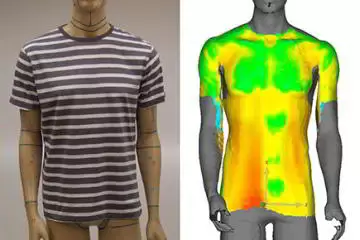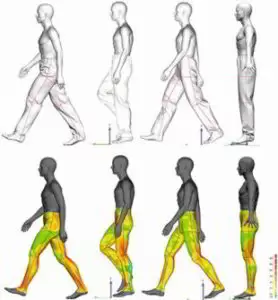
Views: 22
– Computer model calculates heat dissipation beneath clothing. Whether for sports, at work or in the living room – depending on activity and environment, our clothing has to meet different demands. Empa scientists have developed a model that predicts how well a given garment will keep us warm. The crucial factor is the air gap between our body and the outermost layer of clothing.
Courtesy EMPA by Olivia Götschi: In winter, it can look sunny and warm. But as soon as we are exposed to the wind, we start freezing. If our clothing is not adapted to the conditions, we quickly feel uncomfortable. Garment developers, on the other hand, want to adapt their products as closely as possible to the requirements of their customers. To see whether T-shirts, jackets or shoes deliver what they promise, tests with prototypes have been necessary so far. Empa scientists have now developed a computer program that calculates how warm and cozy a person feels when wearing a piece of clothing.
The thermal comfort of, say, a winter jacket is not primarily determined by its fabric. “Much more important are the air layers between the body and the fabric”, explains Empa researcher Agnes Psikuta. “Air gaps are responsible for more than 70% of a garment’s thermal properties.” This is because air is an excellent insulator. Thus, clothing insulates particularly well when there is a lot of air between the body and the outermost layer of clothing. If this air escapes, the insulation suffers and one begins to freeze.
Copied from the fashion industry
To date, most scientific models for predicting heat loss have been based mainly on the properties of fabric that have been used to manufacture a piece of garment. Fabrics, however, fall very differently when a body moves. This also changes the insulating air layers; but only a permanent layer can insulate well. Researchers have, therefore, looked for solutions to calculate the change in air gap thickness during movement. “We used computer programs developed for the fashion industry as a basis. These programs simulate the situation on a catwalk. Designers can create a virtual model of a garment and see how their newly designed clothes look on a person in motion.” It turned out that these computer programs can accurately predict how clothes will drape on the body.
The software developed by Agnes Psikuta and her team combines different mathematical models that interact with each other. In addition to air layers, the program predicts the thermal comfort of the wearer as well as the influence of sweating orbody movements on the garment. Finally, a cutting pattern is transformed into a virtual piece of clothing that can be worn by an avatar.
The program can also help, for instance, to develop an optimal outfit for running in autumn. “Even before the fabrics or the aestetic design have been determined, our software calculates the necessary clothing should fit,” explains Psikuta. And all this not only for standard sizes. “Our program can shape the avatars according to different body types and sizes. If, for example, something is to be developed for particularly muscular, curvy or slender people, we can adapt the program accordingly.”

The software developed by Agnes Psikuta and her team combines different mathematical models that interact with each other. In addition to air layers, the program predicts the thermal comfort of the wearer as well as the influence of sweating orbody movements on the garment. Finally, a cutting pattern is transformed into a virtual piece of clothing that can be worn by an avatar.
The program can also help, for instance, to develop an optimal outfit for running in autumn. “Even before the fabrics or the aestetic design have been determined, our software calculates the necessary clothing should fit,” explains Psikuta. And all this not only for standard sizes. “Our program can shape the avatars according to different body types and sizes. If, for example, something is to be developed for particularly muscular, curvy or slender people, we can adapt the program accordingly.”
Development period cut short by 90 percent
In the end, the program helps to replace countless prototypes for the development of new clothing and functional gear. As this also eliminates the need for time-consuming test runs, the development period is reduced by up to 90 percent. “How much time we can actually save depends greatly on the product in question and its complexity”, says Psikuta. “For instance, protective clothing for firefighters – ultimately a health- and life-saving piece of equipment – has a very complex structure, while a sports T-shirt, on the other hand, is quite a bit easier.”
However, operating the computer program is anything but trivial. In order to apply the research results in practice, Empa cooperates with industrial partners who, for example, manufacture functional gear for winter sports. “They come up with new ideas, and we support them with our technology and help them to develop their apparel in the shortest possible time,” says Psikuta. She and her team are also presenting the software at scientific conferences, to continuously develop it further with academic partners and then make it accessible to as many users as possible.
Further information:
Dr. Agnes Psikuta
Biomimetic Membranes and Textiles
Phone +41 58 765 76 73
agnes.psikuta@empa.ch
Prof. Dr. René Rossi
Biomimetic Membranes and Textiles
Phone +41 58 765 77 65
redaktion@empa.ch
Related article: Functional Dyeing Synchronized eco friendly